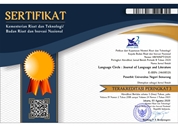TEXTBOOKS ANALYSIS: ANALYZING ENGLISH AS A FOREIGN LANGUAGE (EFL) TEXTBOOKS FROM THE PERSPECTIVE OF INDONESIAN CULTURE
(1) Semarang University, Indonesia
Abstract
Textbooks are very important parts in teaching and learning process. Both teachers and students, mostly, use them as the basic foundations of courses in the classrooms. Textbooks may not be able to fulfill all the needs of the teaching and learning process but their existence as teaching sources is still paramount. They become one of effective sources of learning used in teaching and learning process and as reflection of values and ideas of a person or nation. The aspect of culture can be supported by systematic and comprehensive textbooks. This research paper analyzes some textbooks used in one of Junior High Schools in Indonesia. The way the writer analyzed the textbooks was based on cultural perspective. This is mainly because, in learning English, Indonesian students should focus more on talking and discussing Indonesian culture in English rather than the English speaking countries’ culture. To analyze and examine the cultural contents in the English textbooks, the writer followed the standards set by Bryam. Byram’s criterion is considered sufficient and comprehensive. This set of checklist is driven from the idea of cultural learning and teaching as an integral part of language education. The result shows that the textbooks being analyzed covered local or Indonesian culture. This findings accentuate the needs of revisiting English teaching materials to contribute to the improvement of English Textbooks in Indonesia.
Keywords
Full Text:
PDFReferences
Byram, M. (1993). Language and Culture Learning: The Need for Integration. In Byram. M. (Ed),Germany, its Representation in Textbooks for Teaching German in Great Britain. Frankfurt am Main: Diesterweg, 3-16.
BSNP. (2007). Peraturan Menteri Pendidikan Nasional Republik Indonesia No. 41 Tahun 2007 Tentang Standar Proses. Jakarta: Badan Standar Nasional Pendidikan.
Celce-Murcia, M., Z. Dornyei, S. Thrurrell. (1995). Communicative Competence:
Celce-Murcia, M. (1991). Language Teaching Approaches: An Overview. In M. Celce-Murcia, Teaching English as a Second or Foreign Language (pp. 3-10). Massachusetts: Heinle & Heinle Publisher.
Connole, H., Smith, B., & Wiseman, R. (1993). Research Methodology 1: Issues and Method in Research. Victoria: Deakin University.
Cook. V. (1999). Going beyond the native speaker in language teaching. TESOL Quarterly 33: 185-209
Crystal, D. (1997). English as a Global Language, Cambridge: Cambridge University Press.
Crystal, D. (2003a). English as a Global Language, 2nd edition. Cambridge: Cambridge University Press
Crystal, D. (2003b). The Cambridge Encyclopedia of the English Language, 2nd edition. Cambridge: Cambridge University Press.
Dardjowidjojo, S. (2000) “English Teaching in Indonesia”. The English Australia Journal 18(1): 2-30
Depdiknas. (2004). KURIKULUM 2004: STANDAR KOMPETENSI BAHASA INGGRIS. (English Curriculum 2004: Standard Competence) Jakarta: Depdiknas, available from http://www.puskur.net/download/kbk/SK/smp/BahasaInggris.pdf [2 July 2010]
Depdiknas. (2005). Peraturan Pemerintah No. 19 Tahun 2005 Tentang Standar Nasional Pendidikan. Jakarta: Depdiknas.
Dikdasmen. (2004). Pedoman Umum Pengembangan Silabus Berbasis Kompetensi Siswa SMP. Jakarta: Depdiknas.
Dikdasmen. (2000). Penyempurnaan/Penyesuaian Kurikulum 1994 SLTP (Suplemen GBBP). Jakarta: Departemen Pendidikan Nasional.
Dubin, F., & Olshtain, E. (1986). Course Design. New York: Cambridge University Press.
Emilia, E. (2005). A Critical Genre-Based Approach to Teaching Academic Writing in a Tertiary EFL Context in Indonesia. Melbourne: Unpublished Thesis.
Graddol. D. (1999). The decline of the native speaker. AILA Review 13: 57-88.
Jenkins, J. (2003). World Englishes. A resource Book for Students. London: Routledge
Jenkins, J. (2006). “Current perspectives on teaching World Englishes and English as a Lingua Franca.” TESOL Quarterly 40(1): 157-181.
Jenkins, J. (2007). English as a Lingua Franca: Attitude and Identity. Oxford: Oxford University Press
Jenkins, J. (2009) World Englishes: A Resource Book for Students (2nd Edition). London: Routledge
Kachru. B. B. (1992). Models for non-native Englishes. In B. B. Kachru (ed.). The Other Tongue. Urbana: University of Illinois Press.
Kachru , B. B., Kachru, Y. and Nelson, C. (2006). The Handbook of World Englishes. Oxford: Blackwell
Kern, R. (2000) Literacy and Language Teaching. Oxford: Oxford University Press.
Kirkpatrick, A. (2007). World Englishes: Implications for International Communication and English Language Teaching. Cambridge: Cambridge University Press
Kirkpatrick, A. (2010). English as a Lingua Franca in ASEAN: A Multilingual Model, Hong Kong: Hong Kong University Press
McCarthy, M. and Carter, R. (1994). Language as Discourse: Perspectives for Language Teaching. London: Longman.
McKay, S. L. (2002) .Teaching English as an international language: Rethinking goals and approaches. Oxford: Oxford University Press
McKay, S. L. (2003). “Toward an Appropriate EIL Pedagogy: Re-examining Common ELT Assumptions.” International Journal of Applied Linguistics, 13(1), 1-22.
McKay, S.L and Bokhorst-Heng, W.D. (2008) International English in Its Sociolinguistic Contexts: Towards a Socially Sensitive EIL Pedagogy. New York: Routledge.
Mettler, S.K. (1991). “The Reactions of Listeners to the Discourse of Non Native Speakers of English.” College ESL-Journal of Theory and Practice in the Teaching of English as a Second Language 1(2): 9-20
Pickering, L. (2001). “Intelligibility in English as a Lingua Franca” available from http://www2.gsu.edu/~wwwlup/aralproofs.pdf [26 April 2011]
Richards. J. and T. Rodgers. (1985). Method: approach, design, and procedure. In J. Richards (ed.). The Context of Language Teaching. Cambridge: Cambridge University Press.
UUSPN/Undang-Undang Sistem Pendidikan Nasional. (2003). Sistem Pendidikan Nasional (National Education System). Jakarta: Depdiknas
Refbacks
- There are currently no refbacks.

This work is licensed under a Creative Commons Attribution 4.0 International License

